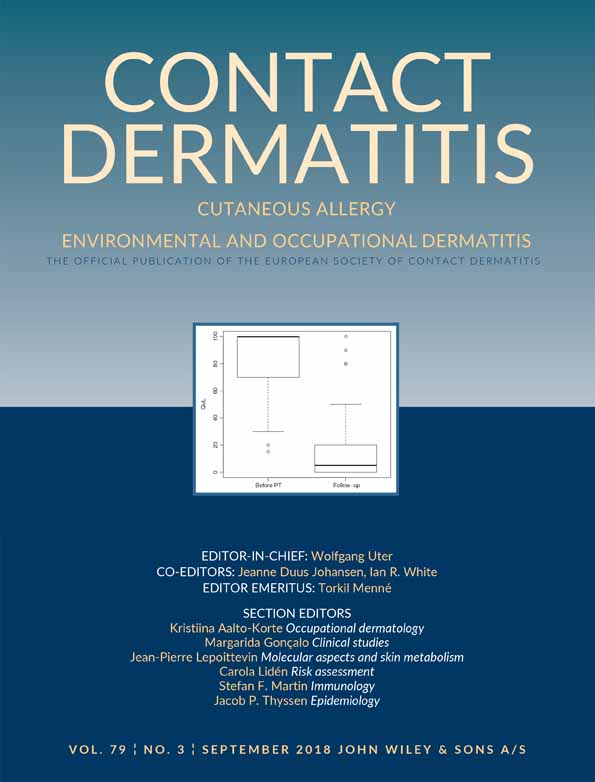Contact dermatitis caused by dialkylcarbamoyl compounds in a medication used for chronic wounds
Monica Corazza
Section of Dermatology and Infectious Diseases, Department of Medical Sciences, University of Ferrara, Ferrara, Italy
Search for more papers by this authorCorresponding Author
Graziana Amendolagine
Section of Dermatology and Infectious Diseases, Department of Medical Sciences, University of Ferrara, Ferrara, Italy
Correspondence
Dr Graziana Amendolagine, Section of Dermatology and Infectious Diseases, Department of Medical Sciences, University of Ferrara, Via L. Ariosto 35, 44121 Ferrara, Italy.
Email: [email protected]
Search for more papers by this authorDario Cristofaro
Section of Chemistry, Department of Chemical and Pharmaceutical Sciences, University of Ferrara, Ferrara, Italy
Search for more papers by this authorTatiana Bernardi
Section of Chemistry, Department of Chemical and Pharmaceutical Sciences, University of Ferrara, Ferrara, Italy
Search for more papers by this authorAlessandro Borghi
Section of Dermatology and Infectious Diseases, Department of Medical Sciences, University of Ferrara, Ferrara, Italy
Search for more papers by this authorMonica Corazza
Section of Dermatology and Infectious Diseases, Department of Medical Sciences, University of Ferrara, Ferrara, Italy
Search for more papers by this authorCorresponding Author
Graziana Amendolagine
Section of Dermatology and Infectious Diseases, Department of Medical Sciences, University of Ferrara, Ferrara, Italy
Correspondence
Dr Graziana Amendolagine, Section of Dermatology and Infectious Diseases, Department of Medical Sciences, University of Ferrara, Via L. Ariosto 35, 44121 Ferrara, Italy.
Email: [email protected]
Search for more papers by this authorDario Cristofaro
Section of Chemistry, Department of Chemical and Pharmaceutical Sciences, University of Ferrara, Ferrara, Italy
Search for more papers by this authorTatiana Bernardi
Section of Chemistry, Department of Chemical and Pharmaceutical Sciences, University of Ferrara, Ferrara, Italy
Search for more papers by this authorAlessandro Borghi
Section of Dermatology and Infectious Diseases, Department of Medical Sciences, University of Ferrara, Ferrara, Italy
Search for more papers by this author
Supporting Information
| Filename | Description |
|---|---|
| cod13019-sup-0001-FileS1.docWord document, 3.7 MB | File S1. Dye extraction process and analytical methods. |
Please note: The publisher is not responsible for the content or functionality of any supporting information supplied by the authors. Any queries (other than missing content) should be directed to the corresponding author for the article.
REFERENCES
- 1Goossens A, Cleenewerck MB. New wound dressings: classification, tolerance. Eur J Dermatol. 2010; 20: 24-26.
- 2Erfurt-Berge C, Geier J, Mahler V. The current spectrum of contact sensitization in patients with chronic leg ulcers or stasis dermatitis—new data from the Information Network of Departments of Dermatology (IVDK). Contact Dermatitis. 2017; 77: 151-158.
- 3D'Erme AM, Iannone M, Dini V, Romanelli M. Contact dermatitis in patients with chronic leg ulcers: a common and neglected problem: a review 2000–2015. J Wound Care. 2016; 25: S23-S29.
- 4Cutting K, McGuire J. Safe, long-term management of bioburden that helps promote healing evidence review of DACC technology. J Wound Care. 2015; 24: S3-S5.
- 5Totty JP, Bua N, Smith GE, et al. Dialkylcarbamoyl chloride (DACC)-coated dressings in the management and prevention of wound infection: a systematic review. J Wound Care. 2017; 26: 107-114.




